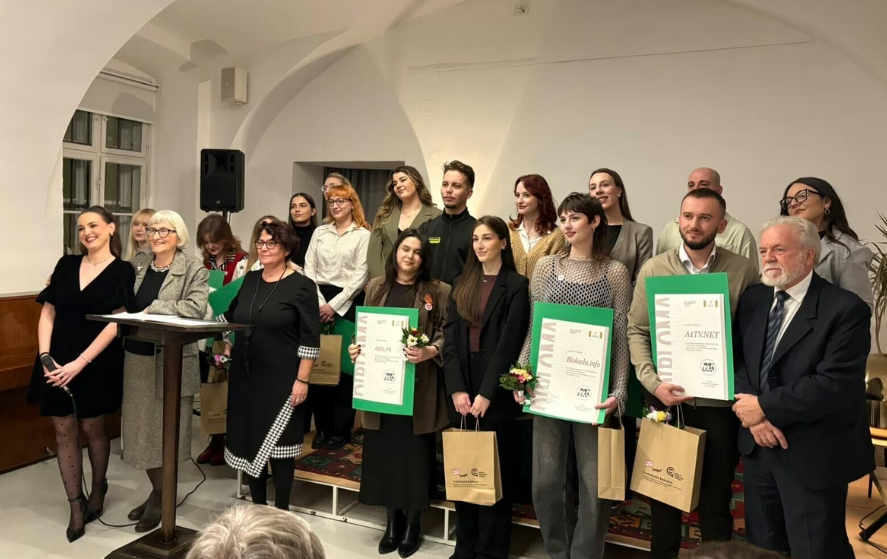Veljko Milić: Violent individuals view female journalists as easier targets.
"The position of journalists has significantly deteriorated… It is indicative that they are mostly subjected to attacks and excessive use of force by the police. Unfortunately, the police still do not understand that their role at public gatherings is not to prevent journalists from reporting, but rather the opposite – to ensure safe conditions so that journalists can work."

Lawyer, attorney, and legal expert of the Independent Journalists' Association of Vojvodina (NDNV) Veljko Milić, who is also a member of the Permanent Working Group for the Safety of Journalists (SRG), speaks to “Vreme” about the achievements of the SRG, the endangerment of female journalists during crisis reporting, and the room for improvement in enhancing their safety.
“VREME”: What are the key achievements of the Permanent Working Group for the Safety of Journalists since its establishment to date?
VELJKO MILIĆ: Since the establishment of the SRG for the safety of journalists, certain progress has been made, thanks to the activities of the Supreme Public Prosecutor's Office. First, all public prosecutor's offices in the Republic of Serbia maintain records of events reported as criminal acts committed against journalists. Based on this record, the Supreme Public Prosecutor's Office provides SRG members with a quarterly bulletin, which includes information on all individual reported cases. A system of contact points has been established within journalistic and media associations that are SRG members, at every police station, and at every prosecutor's office in Serbia. This system allows journalists to have a contact point in their association available 24/7, where they can report an event they believe to be a criminal act; the contact point from the association then notifies the contact points in the police and prosecutor's office, which are obligated to act urgently on the report. Additionally, all prosecutor's offices in the country are required to act urgently in cases involving criminal acts against journalists. Alongside the system of contact points, a Safe Line has been established (telephone number: 0800 100115), which is also available to journalists 24/7, where they can report any events they believe threaten their safety and receive appropriate legal advice. Furthermore, the SRG has served as a good communication channel with the prosecutor's office and police, where representatives of journalistic and media associations could generally obtain information about current cases.
What are the key activities and achievements of the SRG regarding the safety of female journalists?
This issue has primarily been addressed using the mechanisms I have already mentioned. In addition, the records maintained by the Supreme Public Prosecutor's Office are now categorized by gender, providing precise data on the percentage of attacks on female journalists versus male journalists. It has been common for female journalists whose safety is threatened to be invited to attend SRG meetings, providing them with some form of support and more information regarding their cases.
What is your opinion on the position of female journalists and journalists reporting from protests over the past year?
The situation has significantly worsened and is undoubtedly the worst since the establishment of the SRG for the safety of journalists. It is indicative that they are primarily subjected to attacks and excessive use of force by the police. Unfortunately, the police still do not understand that their role at public gatherings is not to prevent journalists from reporting but rather to ensure safe conditions for journalists to work. In addition to physical assaults, confiscation of phones and work equipment, female journalists are also exposed to misogynistic comments and threats received through social media.
What are the key shortcomings of the Permanent Working Group, and where is there the most room for improvement?
Despite all the efforts of SRG members to improve the safety of journalists, the perception of the endangerment of journalists has remained, at best, the same, and in the past year has worsened. To be honest, at the beginning of 2025, journalistic and media associations froze their participation in the SRG, so it is not currently holding regular meetings. In any case, concerning the number of reported criminal acts against journalists, there remains a significant number of perpetrators who have never been identified, and very few court proceedings have concluded with a conviction. All of this discourages journalists and female journalists from reporting criminal acts altogether.
Are female journalists today more endangered than before? Why?
Female journalists have always been more endangered than their male colleagues because, in addition to the general animosity towards journalists in society, which is continually stoked by representatives of the authorities, female journalists face additional harassment due to their gender. My personal impression is that the number of physical attacks on female journalists is higher than on male journalists, as aggressors consider them to be easier targets.
Source: Vreme
Related Articles

Milan Jovanović: Today it is worse for journalists than when they burned down my house. I escaped death, and you young people should be careful.

Awards presented by the "Marina Kovačev" Journalism School: Among the recipients are Blokada.info, University Echo...




.jpg&w=3840&q=75)





